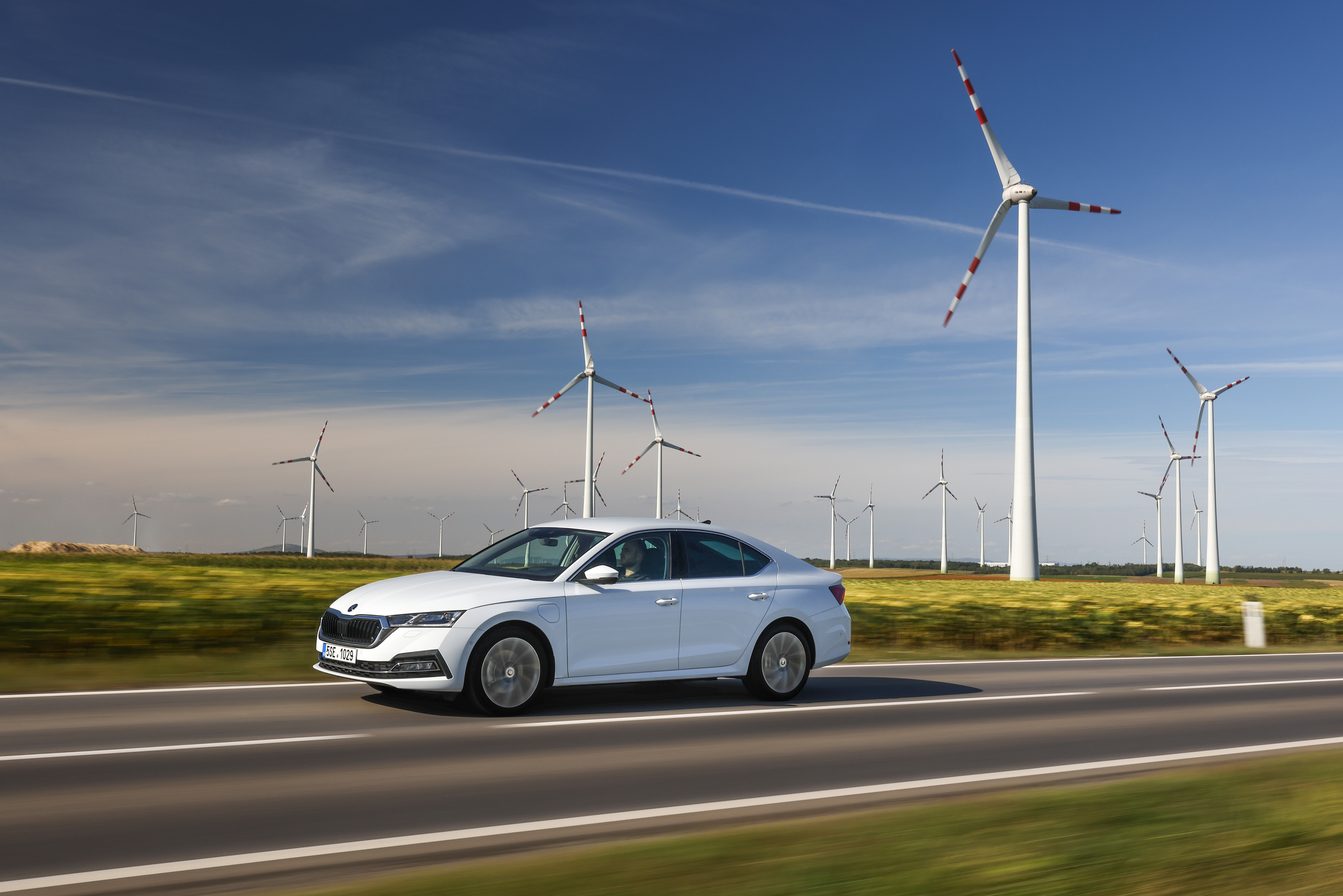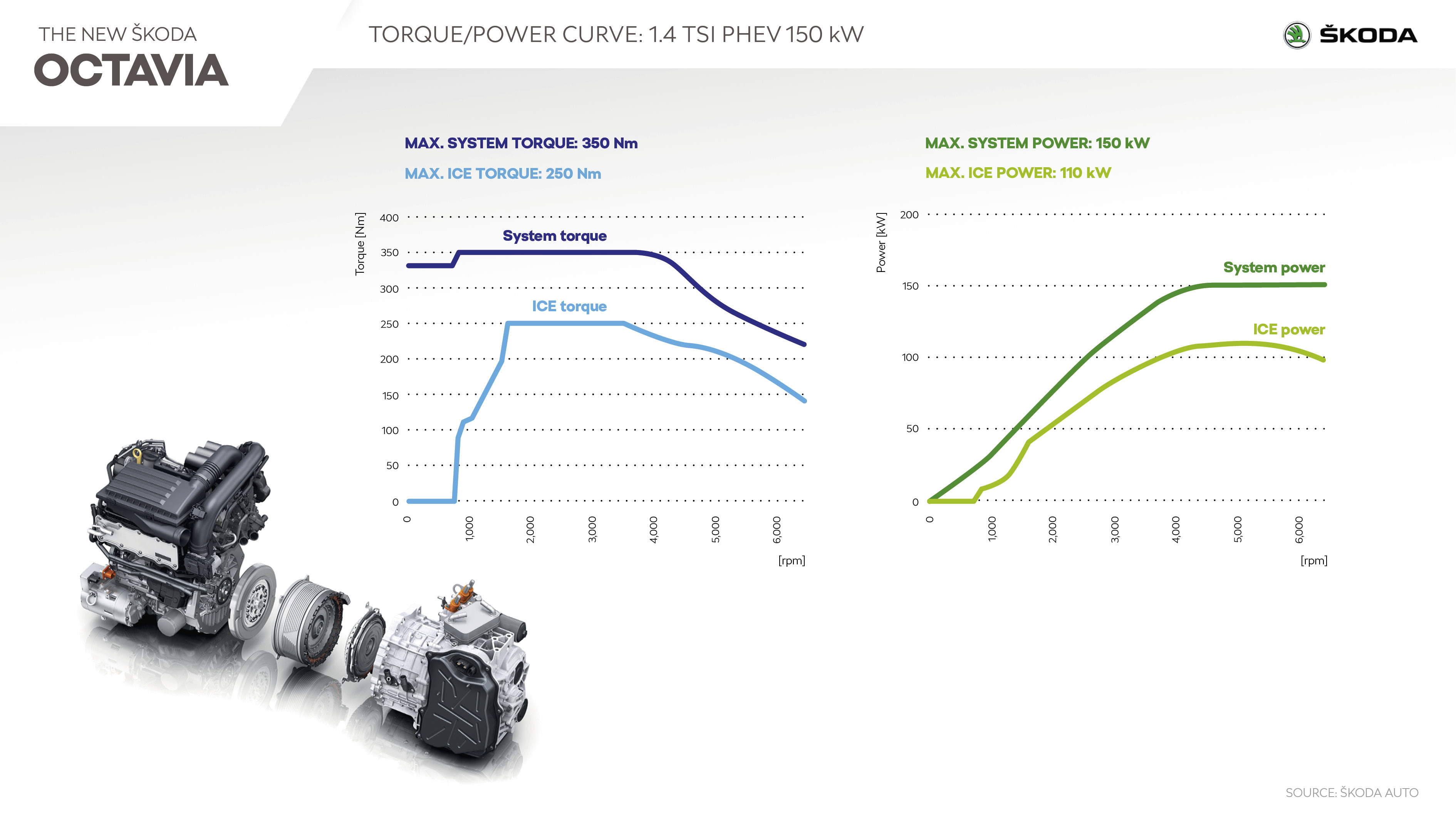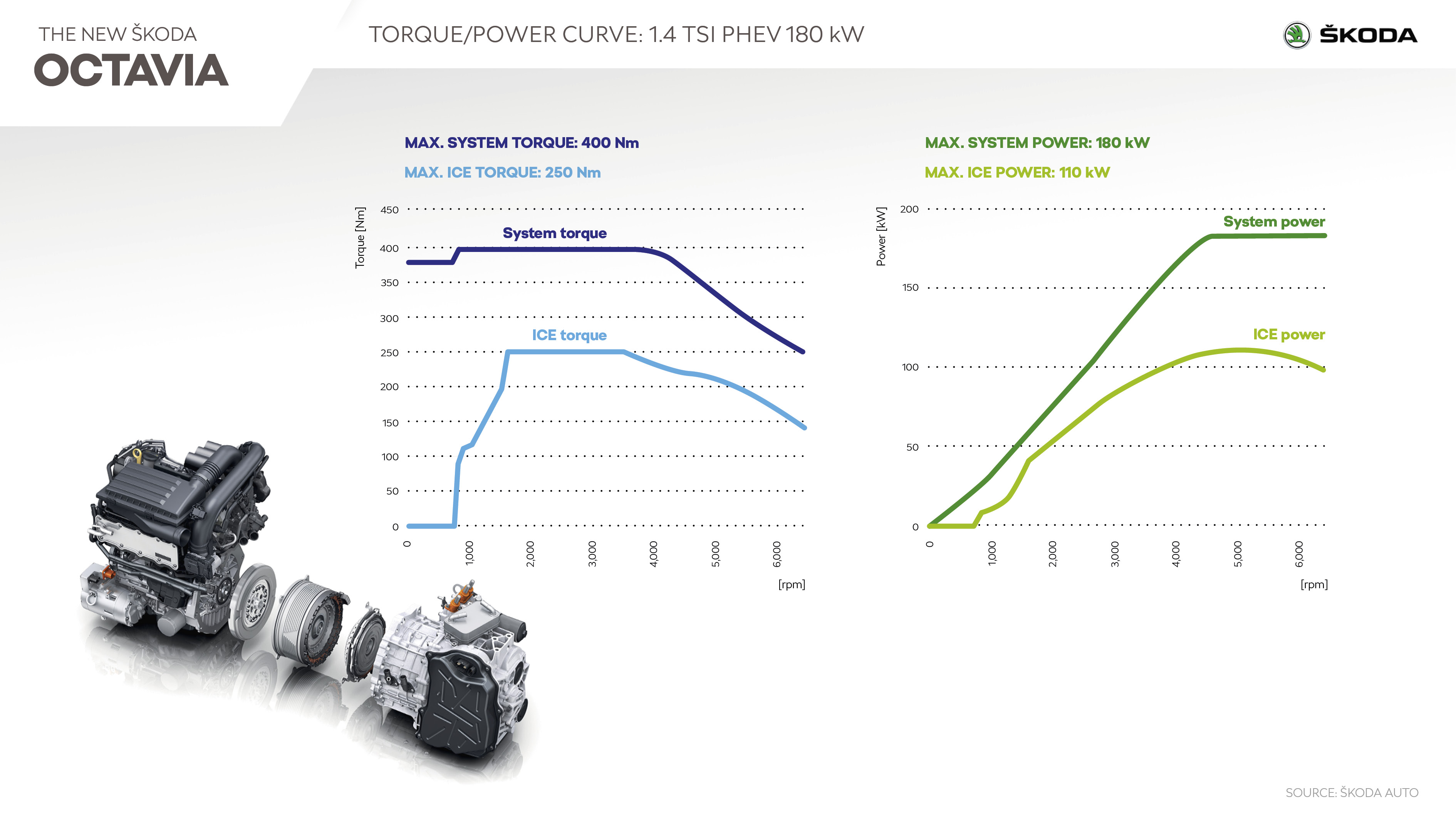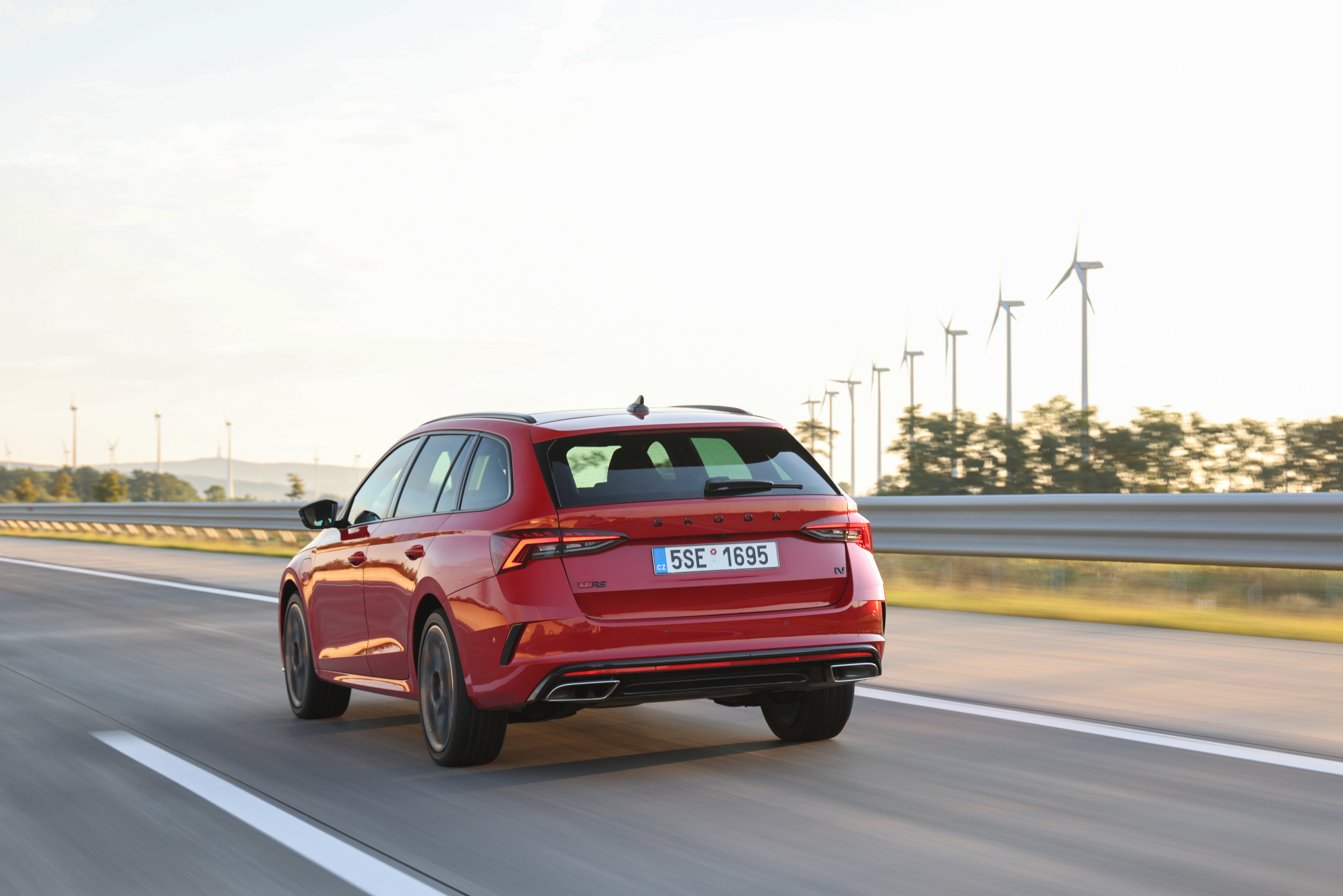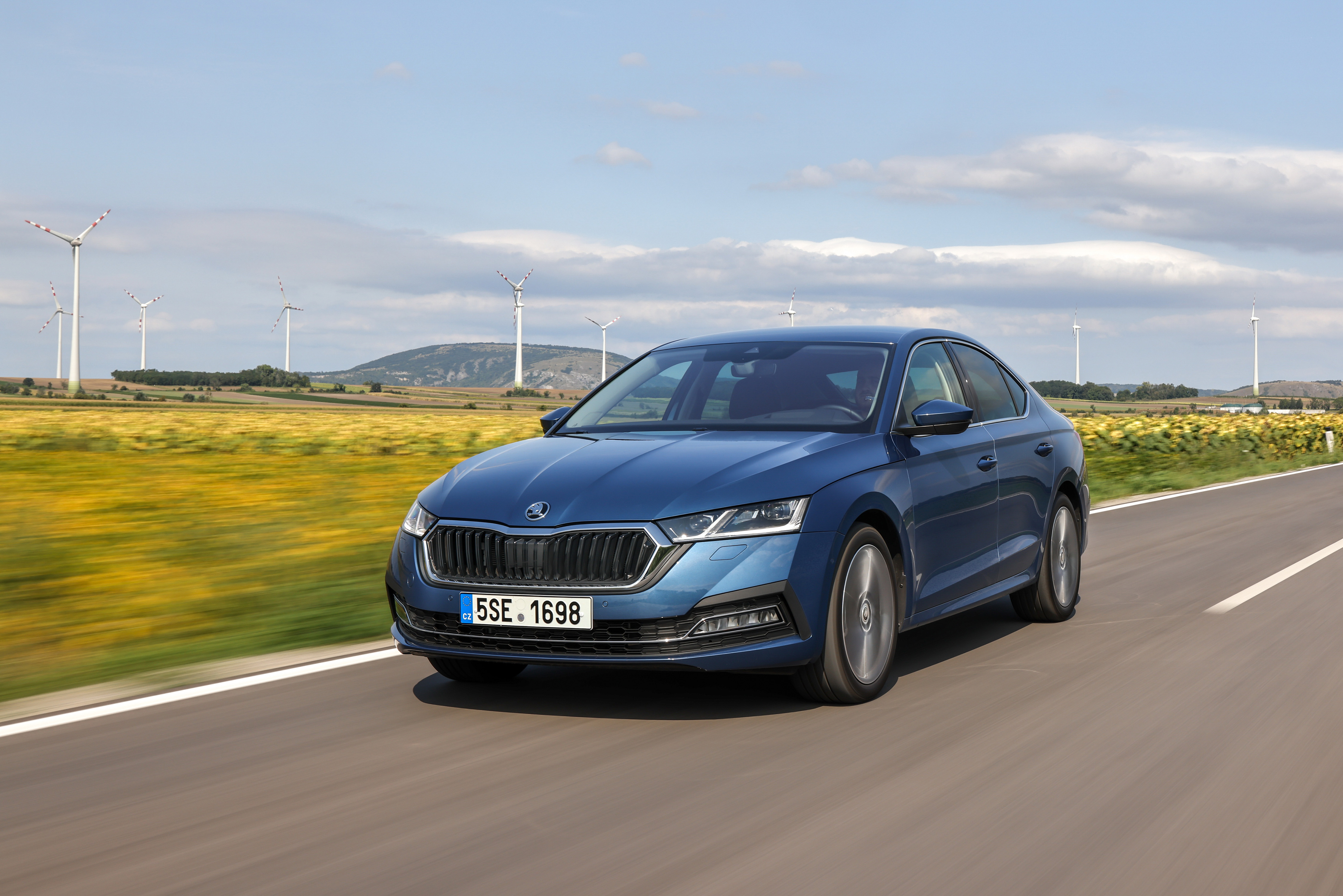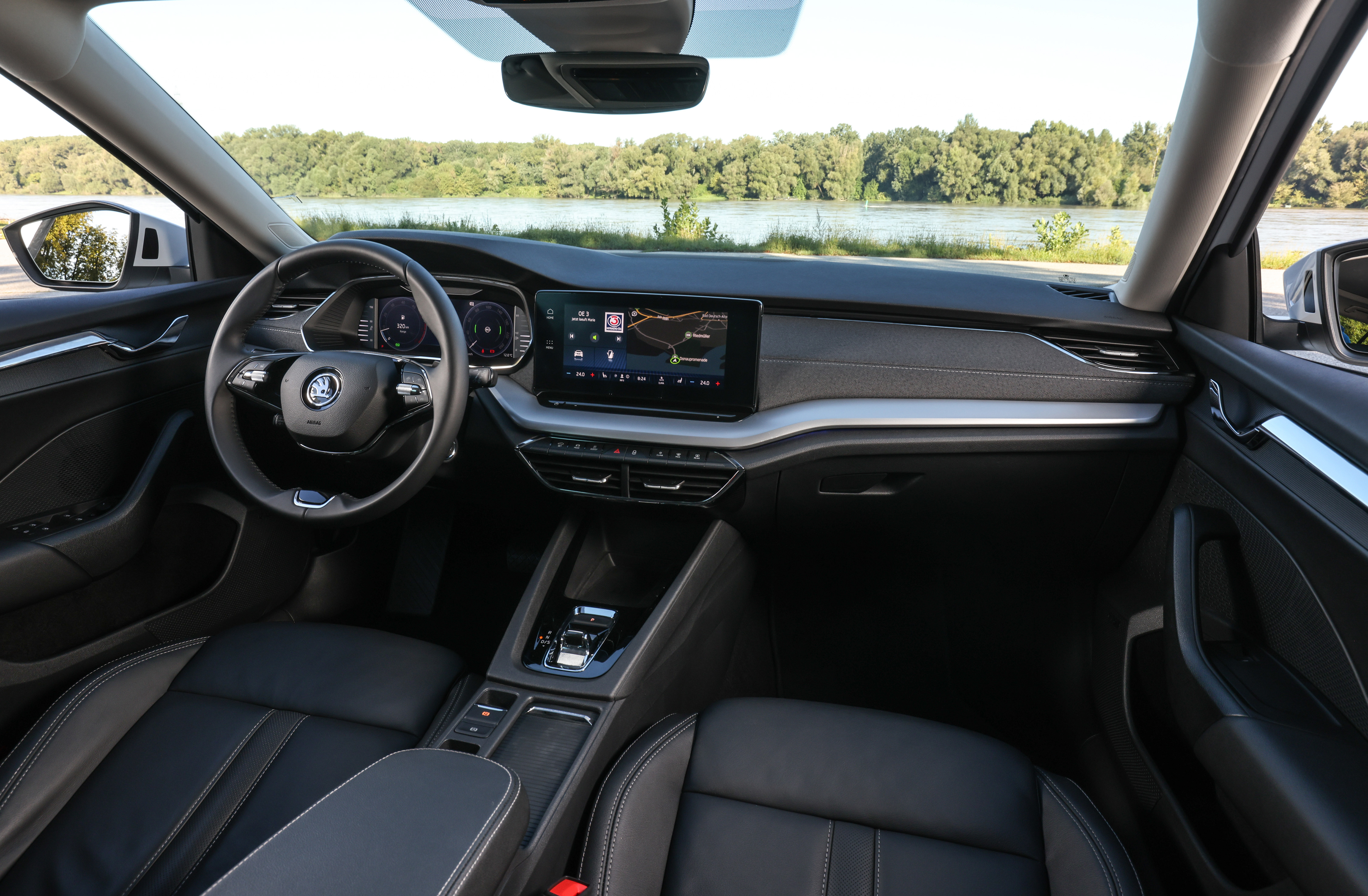› Three alternative powertrains available for the bestseller in the ŠKODA model range: plug in hybrid, mild hybrid and natural gas
› Fourth-generation OCTAVIA boasts innovative assistance systems and supreme active and passive safety
› Progressive infotainment, built-in eSIM and comprehensive connectivity backed by online data
Mladá Boleslav, 14 September 2020 – The launch of the fourth-generation OCTAVIA sees ŠKODA reach new heights yet again: The brand’s bestseller is even more emotive and offers an even greater level of active and passive safety. Furthermore, it comes with plenty of new assistance systems and advanced infotainment. Available with an efficient petrol or diesel engine, or one of three alternative powertrains, the new-generation OCTAVIA is also significantly more sustainable. The OCTAVIA e-TEC is the first ever ŠKODA to feature mild hybrid technology. The OCTAVIA iV and the sporty OCTAVIA RS iV are modern plug-in hybrids and the OCTAVIA G-TEC is designed to run on eco-friendly natural gas (CNG). Thanks to the three sustainable powertrain variants, the new OCTAVIA’s CO₂ emissions have been considerably reduced.
In its fourth generation, the ŠKODA OCTAVIA is once again available as a hatchback and an estate; a rugged SCOUT and three sporty RS versions have also been added to the line-up. Fitted with a choice of front- or all-wheel drive and manual or automatic DSG transmissions, there is an OCTAVIA to suit every ŠKODA customer.
The fourth generation since the modern-day OCTAVIA’s launch in 1996 will further cement the model line as the brand’s heart and engine as well as its top volume model. With more than seven million produced, the OCTAVIA is the bestselling ŠKODA ever and a real icon in numerous international markets. In addition to its domestic market, the Czech Republic, the OCTAVIA tops the bestseller lists in seven other countries, including Poland, Austria, Switzerland and Finland. In its second-largest sales market, Germany, the OCTAVIA has been the most sought-after import vehicle for years. The OCTAVIA COMBI, Europe’s most popular estate, has played a major part in this.
ŠKODA manufactures up to 400,000 units of its bestseller each year. The OCTAVIA is the brand’s only model to be made in four different countries: it rolls off production lines in the Czech Republic, China, Russia and India.
The reasons for the OCTAVIA’s success story are obvious: In addition to its ŠKODA-typical generous amounts of space and excellent value for money, the brand’s heart and engine provides an impressive level of safety too – as illustrated by its five-star rating in the Euro NCAP tests. In its fourth generation, the OCTAVIA offers numerous innovative safety and assistance systems. These include Park Assist with Area View whose four cameras create a 360-degree image of the vehicle’s immediate surroundings, Adaptive Lane Assist, which is able to identify roadworks as well as conventional road markings, and the Local Traffic Warning function that automatically warns of traffic hold-ups in the car’s vicinity, such as the end of a traffic jam. For the first time, ŠKODA is offering the new head-up display for the OCTAVIA; this projects information such as the car’s speed, navigation instructions, detected traffic signs and activated driver assistance systems directly onto the windscreen.
The OCTAVIA offers a choice of three infotainment systems from the latest generation with screens measuring between 8.25 and 10 inches. Thanks to a built-in eSIM, the vehicle is always online – thus enabling the use of new ŠKODA Connect online services.
Three alternative powertrains: plug-in hybrid, mild hybrid and CNG
The three letter combinations – iV, e-TEC and G-TEC – make reference to the wide range of new alternative powertrain variants available for the new ŠKODA OCTAVIA. Both the OCTAVIA iV and OCTAVIA RS iV feature plug-in hybrid drive and provide an all-electric and therefore zero-emission range of up to 60 km in the WLTP cycle. The e-TEC designation is new to ŠKODA and is reserved for cars equipped with mild hybrid technology – another first for the brand. The TSI petrol engines in these models are electrified by a 48-V belt-driven starter motor and a 48-V lithium-ion battery. The OCTAVIA G-TEC primarily uses eco-friendly compressed natural gas (CNG). This type of fuel boasts cleaner combustion, meaning that CO₂ emissions are approximately 25 per cent lower than when running on petrol.
Christian Strube, ŠKODA AUTO Board Member for Technical Development, said, “When developing the new OCTAVIA, we focused from the outset on considerably reducing the amount of aerodynamic drag as well as the CO₂ and NOx emissions even further. As a result, the choice of powertrains available for the new OCTAVIA is greater than ever before. The car can be ordered as an e-TEC that features the new mild hybrid technology, as one of two iV plug-in hybrids or as an OCTAVIA G-TEC which runs on eco-friendly natural gas. This way, we have achieved a significant boost in efficiency and sustainability, as well as the highest level of functionality and versatility. This means that the OCTAVIA, now in its fourth generation, impresses by providing just what our customers cherish so much.”
Two beating hearts for the ŠKODA OCTAVIA iV and ŠKODA OCTAVIA RS iV
Following in the flagship SUPERB iV’s footsteps, the new OCTAVIA is the second ŠKODA iV plug‑in hybrid – available not just in one but two power variants. The OCTAVIA iV comes in the Ambition trim level or higher (except for the SCOUT version) and has a power output of 150 kW (204 PS); its maximum torque is 350 Nm. The sporty OCTAVIA RS iV produces 180 kW (245 PS) and a maximum torque of 400 Nm. In Sport mode, which allows drivers to make use of the car’s full power output, both body variants of the OCTAVIA RS iV accelerate from 0 to 100 km/h in just 7.3 seconds and their top speed is 225 km/h. Compared to the equivalent version fitted with a petrol engine and DSG transmission, the sprint from 80 to 120 km/h is 2.2 seconds quicker. The progressive steering that comes as standard and dynamic tuning of the sports suspension that is typical for the RS range cater to energetic driving styles. Both iV models of the fourth-generation ŠKODA bestseller are equipped with a 6-speed direct-shift gearbox and feature shift-by-wire technology for selecting the gears. The hatchback offers a boot capacity of 450 l; the OCTAVIA COMBI can hold 490 l. The OCTAVIA RS iV also comes with a sports suspension specially adjusted for the RS. As in the OCTAVIA iV, its ground clearance is 143 mm.
Both OCTAVIA iV variants are powered by a 1.4 TSI petrol engine delivering 110 kW (150 PS) and an 85-kW electric motor, whose operations are controlled electronically. Individual software calibration in the two vehicles provides different power outputs. At 85 kW, the electric motor used in the OCTAVIA iVs produces the same output as the motor fitted in the SUPERB iV. It has, however, been enhanced from a technical point of view. The three-phase permanent magnet excited electric motor has been integrated into the 6-speed direct-shift gearbox and separated from the combustion engine by a clutch.
All-electric range of up to 60 km in the WLTP cycle
The OCTAVIA iV and OCTAVIA RS iV both feature a high-voltage lithium-ion battery with a capacity of 37 Ah and providing 13 kWh. This enables an all-electric and therefore zero‑emission‑range of up to 60 km in the WLTP cycle. In electric driving mode at speeds of up to 50 km/h, the E-noise sound generator fitted under the right front wing produces a specific noise, helping pedestrians and cyclists to hear the electric OCTAVIA iV sooner and more easily. Overall, CO₂ emissions amount to only about 30 g/km, meaning the car already meets the requirements for the future Euro 6d emissions standard. The battery can be conveniently charged using a standard household plug socket or wall box. From a 230-V socket, it takes 3 hours 45 minutes to recharge from 0 to 80 per cent and 5 hours to reach 100 per cent. When using a 3.6-kW wall box, it takes just 2 hours 33 minutes for the battery to arrive at 80 per cent of its capacity and 3 hours 33 minutes to fully recharge. The charging port is located behind a flap in the front wing on the driver’s side, which opens by pressing a button in the door panel. In addition to the traction battery, both OCTAVIA iVs come with a 12-V battery located in the boot. This powers the car’s low-voltage systems.
Electric or hybrid: drive and mode chosen via Driving Mode Select
Driving Mode Select is a familiar feature found in other ŠKODAs. In the OCTAVIA iV and OCTAVIA RS iV, Eco, Normal, Sport and Individual driving modes can be chosen – as well as a Comfort option if the car is fitted with Dynamic Chassis Control (DCC). These allow settings for the steering or the engine and transmission control, for example, to be adjusted. The driver can also switch between E-mode and Hybrid mode on the central Driving Mode Select display.
Speeds of up to 140 km/h in E-mode
The OCTAVIA iV and OCTAVIA RS iV are powered exclusively by the electric motor in E-mode, making this setting ideal for driving in urban traffic. If its battery has sufficient charge and the outside temperature is above ‑10°C, the vehicle is powered electrically as soon as it is switched on. For technical reasons, this mode is not available in temperatures below -10°C. Using all-electric drive, the maximum power output is 85 kW; the top speed in this mode is 140 km/h.
Automatic Hybrid mode with two battery charging options
In Hybrid mode, the electronic control unit continuously assesses the current driving situation. As soon as the vehicle is in motion, interaction between the petrol engine and electric motor is automatically regulated. Either they complement one another when used simultaneously, or the electronics activate only one of them. Hybrid mode also offers the option of charging the battery via recuperation or the engine whilst the car is moving. If the box marked ‘Auto’ in the central display is left unticked, the driver can set their own desired battery level. If the current charge is below the specified amount, the vehicle tops up the battery using the petrol engine and brake energy recovery until the desired mark is reached. If the current charge is higher than specified, the energy is used until the desired level is met, and this is then maintained. If ‘Auto’ is ticked, the charging system operates completely autonomously. This means the control unit decides based on the current driving situation when to draw power from the battery and when to recharge it using recovered energy. In Hybrid mode, an output of 110 kW (150 PS) is available at all times. The maximum power output of 150 kW (204 PS) for the OCTAVIA iV and 180 kW (245 PS) for the OCTAVIA RS iV is accessed when the accelerator is pushed down fully (kickdown) or Sport mode is selected.
Brake energy recovery works automatically or can be set by the driver
Energy recovery during braking helps to effectively increase the range of an electrified vehicle, as the battery is charged using recuperation whilst the car is in motion. During automatic recuperation, the car autonomously adjusts the degree of braking to suit the current driving situation. This not only recovers energy, it also reduces the wear on the brakes, saves fuel and makes driving safer. Using the intelligent Traffic Sign Recognition function and by processing data supplied by cameras and radar sensors, ŠKODA OCTAVIA iVs can continuously determine the optimal level of recuperation for the given situation. In addition to the automatic setting when in the regular driving mode (D), two other levels can be manually selected via the central display: a particularly low level of recuperation, which allows the vehicle to roll to a stop as well as to coast with the engine disengaged, and a level involving higher deceleration which slows the car down at a rate of 1.2 m/s². This level recovers a particularly high amount of energy and can also be set in the OCTAVIA iVs by opting for Sport mode in Driving Mode Select or engaging S (Sport) using the small rocker switch on the centre console. Brake energy is recovered until the battery is fully charged.
Predictive Efficiency Assist helps to ensure safe and efficient driving
The intelligent Predictive Efficiency Assist helps those driving the OCTAVIA iV and OCTAVIA RS iV to do so safely and efficiently. This system brings together brake energy recovery and Eco Assist, which can be switched off if desired. Even in the standard version of the new ŠKODA OCTAVIA, Eco Assist displays efficient driving tips on the Virtual Cockpit. The interaction between these two assistance systems means that the car alerts its driver in good time when approaching a roundabout, for example, or a speed restriction. When the driver reduces the speed, the OCTAVIA automatically adjusts the degree of brake energy recovery in order to slow down as efficiently as possible. Just like the equally powerful RS variant featuring a 2.0 TSI petrol engine, the ŠKODA OCTAVIA RS iV is equipped with ventilated brake discs measuring 340×30 mm on the front axle and 310×22 mm on the rear axle.
OCTAVIA RS iV: sporty exterior with black accents and RS-typical interior
The OCTAVIA RS iV’s sporty talents are evident at first glance. The ŠKODA grille, air curtains, diffuser on the RS-specific front apron, aeroflaps, diffuser on the rear apron and window frames all come in sporty black. The hatchback is fitted with a black RS rear spoiler; in the estate, the roof spoiler matches the body colour. The RS iVs are equipped with LED head lights and black 18‑inch alloy wheels as standard; 19-inch wheels are available on request. The brake callipers come in an RS-typical red finish to catch the eye. The interior of the OCTAVIA RS iV is predominantly black. The three-spoke leather multifunction sports steering wheel bears an RS logo and features paddles for operating the DSG. Providing a dynamic visual touch, the sports seats for the driver and front passenger as well as the rear seats bear the RS emblem and coloured decorative stitching in red or silver-grey, which can also be found on the leather steering wheel, the armrests and the Alcantara®-covered dashboard. Decorative strips in an RS look and pedals with an aluminium design round off the interior’s sporty impression.
OCTAVIA e-TEC: mild hybrid technology makes its ŠKODA debut
The two OCTAVIA e-TECs are the first ŠKODA production cars ever to come with mild hybrid technology. The latest EVO-generation three-cylinder 1.0 TSI delivers 81 kW (110 PS), is equipped with a turbocharger with variable turbine geometry and operates using the efficient Miller combustion process. As with the four‑cylinder 1.5 TSI outputting 110 kW (150 PS), this engine makes use of a 48-V belt-driven starter motor and a 48-V lithium-ion battery when combined with the 7-speed DSG. The battery has a capacity of 0.6 kWh, is located under the front passenger seat and is charged exclusively by brake energy recovery; there is no need for external charging. The starter motor can also power the 12-V starter battery via a DC converter. The main purpose of the mild hybrid technology, however, is to supply the engine with an electrical boost of up to 50 Nm if required and enable the e-TECs to coast with the engine completely disconnected. This reduces fuel consumption by up to 0.4 l per 100 km and lowers CO₂ emissions. Furthermore, the engine can be started more quickly, more smoothly and with less vibration. The OCTAVIAs featuring mild hybrid technology are identifiable by an e-TEC badge on their tailgate.
OCTAVIA G-TEC: designed to run on eco-friendly natural gas
Like the previous generation, the new ŠKODA OCTAVIA is also available in a G-TEC variant that is designed to run on eco-friendly compressed natural gas (CNG). Its 1.5 TSI engine produces 96 kW (131 PS) and features a turbocharger with variable turbine geometry. Natural gas burns more cleanly, resulting in around 25 per cent fewer CO₂ emissions than when running on petrol; in addition, significantly less nitrogen oxide (NOx) is emitted and no soot particles are produced. To ensure a high degree of efficiency, the engine makes use of a variety of technologies, such as variable intake-valve control according to what is known as the Miller combustion process. This means that the OCTAVIA G-TEC’s combined fuel consumption in the WLTP cycle is 3.6–4.5 kg per 100 km* in CNG mode. The CNG capacity of 17.33 kg enables a range of up to 500 km* in the WLTP cycle. What’s more, the OCTAVIA G-TEC can cover a further 190 km* by running on the petrol from its 9-litre tank, giving it a total range of up to 690 km*. The vehicle only accesses the petrol fuel supply in certain situations: this includes when the engine is started after the CNG has been topped up, when starting the vehicle in outside temperatures below -10°C or when the CNG tanks are so low that the tank pressure drops below 11 bar. Switching between CNG and petrol mode always happens automatically without the driver needing to intervene. The OCTAVIA G-TEC bears a specific badge at the rear and has a dedicated layout in the Virtual Cockpit. The hatchback’s boot can hold 455 l, whilst the estate has a boot capacity of 495 l.
*This information is provisional and subject to change.
New cooling louvres optimise aerodynamics and increase cooling efficiency
Using a new type of cooling louvre and the Compactor® concept, ŠKODA has optimised the aerodynamics of the OCTAVIA, reduced CO₂ emissions and made engine and brake cooling more efficient. Actively adjustable louvres in the front bumper’s central air intake improve aerodynamics by closing when there is little need for cooling, and cut off the air supply while the engine is still cold. The louvres can be opened to a different extent depending on the ambient conditions. When fully open, the maximum amount of air flows in, allowing for a high level of cooling, accommodating short stops or being used in regenerating the petrol or diesel particulate filter. As part of the Compactor® concept, this is then distributed in a targeted manner and – with the help of a fan – is also used to cool the brakes.
Progressive infotainment and comprehensive connectivity
For the ŠKODA OCTAVIA, there is a choice of three different infotainment systems from Volkswagen Group’s latest-generation Modular Infotainment Matrix. This means that – thanks to a built-in eSIM – the OCTAVIA is always online providing access to the ŠKODA Connect mobile online services. These include Proactive Service, which features Breakdown Call, and extensive remote vehicle access via the ŠKODA Connect app or the web portal as part of Care Connect. Infotainment Online also offers route calculation backed by online data, real-time traffic information and the new infotainment apps for news and weather. Even the entry-level Swing radio, featuring an 8.25-inch customisable touchscreen, provides DAB reception and boasts wireless SmartLink technology for integrating smartphones as well as Android Auto, Apple CarPlay and MirrorLink™.
Both the Bolero infotainment system, for which a navigation function can be activated at a later stage, and the Columbus navigation system offer a 10-inch touchscreen. They can both also be controlled using gesture commands or the Laura digital voice assistant. Laura is even able to understand fluently spoken complete sentences in six languages. The permanent online connection enables the use of Internet radio and streaming services for music as well as automatic ‘over-the-air’ map updates. The top‑of‑the‑range Columbus infotainment system is also able to display the navigation system’s maps on its 10-inch screen in a different level of zoom to the Virtual Cockpit. This new function can be adjusted via an innovative touch slider located below the display, which can be used to control the volume too.
Premiere for the head-up display and improved Virtual Cockpit
The OCTAVIA is the first ŠKODA to have an optional new head-up display. An electronic unit generates an image from data, such as speed, navigation instructions, detected traffic signs or activated driver assistance systems, and projects it onto the windscreen in clear view of the driver. This allows them to see the most important information without taking their eyes off the road. The head-up display complements the digital, customisable Virtual Cockpit, which ŠKODA has optimised further and made even more user-friendly; it now features a screen measuring 10.25 inches. Using the buttons on the multifunction steering wheel, the driver can select the Basic, Classic, Navigation or Driver Assistance Systems layout and specify their desired content. The Driver Assistance Systems layout shows the active systems three-dimensionally, just like in the central display. The OCTAVIA RS iV comes with an additional Sport layout.
Plenty of new or improved assistance systems for the OCTAVIA
Many of the assistance systems in the new OCTAVIA are making their ŠKODA debut, while others have been further improved. Collision Avoidance Assist supports controlled evasive manoeuvres by actively amplifying the steering moment, thus helping to prevent an imminent collision with a pedestrian, cyclist or other vehicle. When turning left at junctions, Turn Assist warns the driver of oncoming traffic in advance and can even stop the car automatically. Exit Warning lets the occupants know if another vehicle or a cyclist is approaching from behind when opening the car door. The new Local Traffic Warning function automatically alerts the driver of traffic disruptions in the car’s vicinity, such as the end of a traffic jam. When parking or manoeuvring, Area View displays the OCTAVIA’s immediate surroundings in a 360-degree image generated by four cameras. Up to a distance of 70 m, Side Assist warns the driver of vehicles approaching from behind or when they are in the blind spot. In the city, Front Assist including Predictive Pedestrian and Cyclist Protection indicates the potential for a collision visually, acoustically and through gentle braking, and performs an emergency stop when necessary. Predictive Cruise Control uses images from the camera in the windscreen and data from the navigation system to automatically adjust the speed to suit the road ahead. In addition to the improved Traffic Sign Recognition, Adaptive Lane Assist, which also detects roadworks, Traffic Jam Assist and Emergency Assist, it is part of the comprehensive Travel Assist function, which includes Hands-on Detect too. Using Hands-on Detect, the system checks whether the driver is touching the steering wheel every 15 seconds or whether they may no longer have control of the vehicle due to a potential medical emergency. In this case, Emergency Assist activates the hazard lights and brings the car to a stop in its current lane.
ŠKODA AUTO introduces plasma-coated cylinder blocks
› New EA211-series 1.0 TSI petrol engines now feature an ultra-thin plasma coating instead of cast-iron cylinder liners
› Low-friction coating reduces fuel consumption, emissions and weight in the new EVO-generation three-cylinder engines
› 28.8 million euros invested in plasma coating equipment at the Mladá Boleslav plant
Mladá Boleslav, 14 September 2020 – ŠKODA AUTO has put a new processing line for plasma coating into operation. This technically innovative concept allows conventional cylinder liners to be replaced with a powder coating that measures just 150 μm (0.15 mm). This will now be used when producing the new EVO three-cylinder engines from the EA211 series and will reduce internal friction. As a result, the 1.0 TSI EVO petrol engines will be even more efficient and boast even lower emissions. ŠKODA has invested a total of around 29 million euros in preparing and converting its Mladá Boleslav-based headquarters.
Christian Bleiel, Head of Component Production at ŠKODA AUTO, highlighted, “The technically highly innovative plasma coating makes our EA211 TSI EVO engines even more efficient. It reduces friction losses and thus also fuel consumption. What’s more, this type of coating also allows heat to be more evenly distributed within the cylinders and helps it to dissipate more efficiently, thus optimising the thermal load. We produce the plasma-coated engines at Mladá Boleslav in three shifts and are installing them in the FABIA, SCALA, OCTAVIA, KAMIQ and KAROQ.”
This means that the engines featuring plasma coating are also used in the ŠKODA OCTAVIA e-TEC mild hybrids. The Czech car manufacturer has added an assembly line with two special fixtures for plasma coating at its main plant. Both of these include two torches. ŠKODA AUTO has invested a total of 28.8 million euros in upgrading the plant in this way; overall, the carmaker has spent 69.1 million euros on modernising engine production.
During the production process, the cylinders are first bored on the machining line. A 1,500-watt laser then abrades the cylinder bores to ensure that the plasma layer will optimally adhere to the surface. This involves the laser beam creating ten grooves per millimetre, each measuring an average depth of 40 μm. This production step takes place in a controlled atmosphere filled with nitrogen to keep the laser’s optics free from contamination and to ensure the necessary level of accuracy.
A mixture of hydrogen and argon is used to create plasma gas, requiring 4.5 l of hydrogen per minute during the process. The plasma reaches a temperature of 15,000° Celsius and is then mixed with various types of steel that have been ground into fine powder. This powder is made up of iron, carbon, silicon and manganese as well as other necessary elements. The individual powder grains measure no more than 50 μm. When sprayed onto the cylinder walls, the molten powder forms a layer measuring approximately 250 μm. During final processing, this layer is honed out, so that it measures just 150 μm. To put all of this in perspective: the wall of a conventional cylinder liner is 4 mm thick.
Each cylinder is automatically measured at several stages throughout the process to assess its quality. Optical measuring instruments first record the surface abraded by the laser, before a second measurement is taken once the plasma has been applied. Finally, the structure of the plasma layer is tested using turbulent flow.
Hermann Prax
Head of Product Communications
hermann.prax@skoda-auto.cz
T +420 734 298 173
Zbyněk Straškraba
Spokesperson – Product Communications
zbynek.straskraba@skoda-auto.cz
T +420 326 811 785



